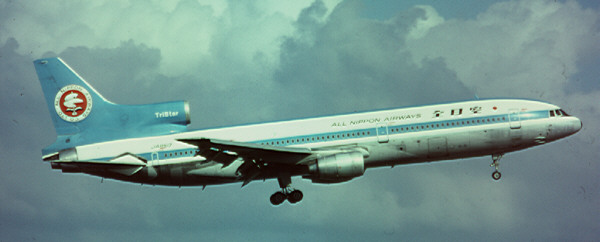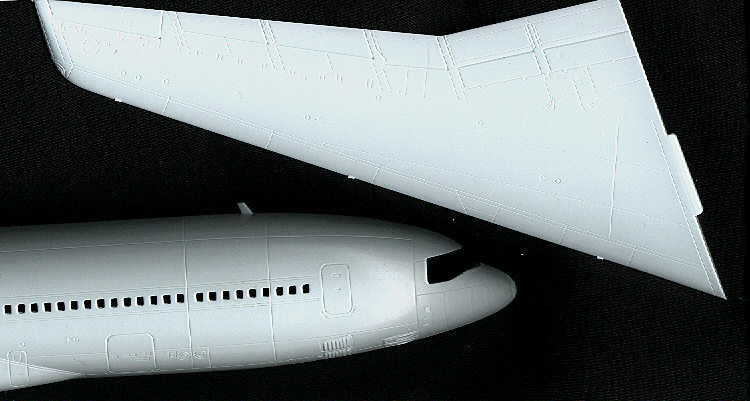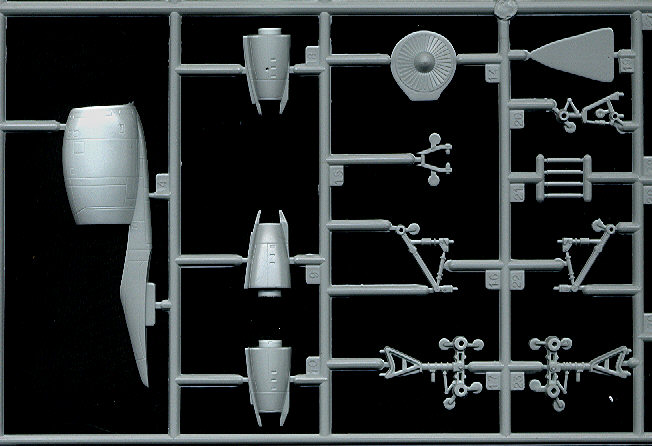

All Nippon Airways L-1011 on final approach to
Tokyo-Haneda, 1986 (Akinobu Okuda)
| KIT: | Otaki 1/144 scale L-1011 TriStar |
| KIT # | OT2-12 |
| PRICE: | US$24.95 new; between $30--75 on the second hand market |
| DECALS: | TWA and All Nippon Airways 1972 delivery schemes |
| REVIEW & PHOTOS BY: | Andrew Abshier |
| NOTES: | By far the finest 1/144th scale kit of the L-1011 available--if you can find one. |


All Nippon Airways L-1011 on final approach to
Tokyo-Haneda, 1986 (Akinobu Okuda)
|
|
In 1966, in response to airline inquiries, Lockheed began studies for a second-generation airliner capable of carrying 250-300 passengers on short to medium haul flights. The design they eventually adopted was a three-engined widebody planform, with the third engine buried in the aft fuselage and fed via an S-duct intake much like the Boeing 727. The L-1011 would mark Lockheed's re-entry into the commercial aircraft market after a 15 year hiatus. It would not be a happy experience.
At the same time, McDonnell-Douglas was finalizing a design of very similar capability, the Douglas DC-10. The Douglas design was different in having a straight duct to the third engine, which was carried as part of the vertical stabilizer. The two aircraft, the DC-10 and L-1011, would fight for orders in the exact same market segment, to the detriment of both. In the end the DC-10 emerged the winner in terms of total orders; problems with Rolls-Royce, the engine contractor, severely set back the L-1011 and caused the loss of a number of important orders for the type. In the end only 250 L-1011s were built, and it became the first widebody airliner to be taken out of production. Since then Lockheed has strictly built military aircraft.
In service, the L-1011 became a popular aircraft with passengers and, in
time, with crews and maintenance personnel. Structurally it has always
been a very solid aircraft; in my research I could find no L-1011 crashes
attributable to structural or mechanical failure, whereas the DC-10 suffered
some horrific crashes due to design faults in its early days. About half
of the 250 L-1011s built remain active, in both passenger and cargo roles.
| HISTORY OF THE KIT |
Before I discuss the parts, going over a bit of the history of the kit seems in order. Otaki released their L-1011 kit in the early 1970s, more or less coincident with the introduction of the L-1011 into service. At the time of its release, two other L-1011 kits were already available, but Otaki's kit effectively superseded both as the kit of choice, even at its exhorbitant (for the time) US$24.95 price tag. The real big-time airliner modelers, myself included, paid the hefty price tag, but the casual builders, at least in the United States, mostly bought the far less expensive Revell or Airfix L-1011s instead.
The L-1011 evidently didn't sell very well for Otaki, because it was the only airliner released under their name; molds for a 1/144th Concorde--like the L-1011, the finest example of its type in injection molded styrene form--were completed, but Otaki had gone out of business by the time they were complete. After Otaki went out of business, the molds were parceled out to other model companies. Arii got the 1/48th scale fighters, most of which are still in issue today, and Revell-Germany took the Concorde mold, but no one, it seemed, took the L-1011 mold.
Many years later, I contacted Scott Hards just after he started his Hobbylink
Japan on-line store, and placed a standing order for any Otaki L-1011s he came
across. He checked into it, and found out that Doyusha had wanted to
reissue the kit, but that the L-1011 molds had been apparently been
destroyed at some point! The news sent shockwaves through the airline
modeling community, and, of course, the collector community.
| THE KIT |

A mint condition Otaki L-1011 comes in a box with individually wrapped sprues, except for the clear parts which share a bag with the landing gear/engines sprue. All are tucked underneath a cardboard band that keeps everything from shifting around.
In addition to the aircraft parts, the kit also includes a display stand and parts to make up two truck-mounted covered steps, molded in orange.
Surface detail is entirely engraved, and is very comprehensive. All of the panel lines seen on actual L-1011s seem to have been given--and there are a lot of them! The scribing sometimes gets a bit heavy, particularly for the passenger and cargo doors, but they should look good underneath paint. The prominent air conditioning vents and louvers around the nose are captured well, and there are even tiny NACA inlets, where appropriate, on the fuselage!
The flying surfaces have lighter scribing, and excellent beveling where the
moving control surfaces meet the fixed areas. Trailing edges are
remarkably thin. No wheel well detail is provided, but it should be easy
to box in the wheel wells on the wings and add some; for the fuselage, all doors
except the minimum are closed except when the gear is actually cycling, so
little or no wheel well detail is needed there.

Detail of the large sprue containing the
engines, landing gear, and horizontal stabilizers.
Otaki made some effort to dampen the "black hole" effect on the center inlet. A plate is given to partially blank off the bottom of the inlet (part 19 on the sprue scan above), and a compressor fan is given for the center engine. However, the hollow area leading up to the vertical fin and the stabilizer tabs will still be visible once this is built. I'll have to think about ways to approach this problem, as it is a vexing one! To be fair, no manufacturer has ever done a full S-duct for any airliner type that has one.
The engines are accurate representations of the early RB-211s flown on L-1011s as delivered. These had the long hot stream cowlings (tailpipes) with external fairings above and below (parts 9 and 10 above). Trailing edges on the cold stream cowling/strut parts are nice and sharp; the trailing edges on the hot stream cowlings could stand some reaming out with a rat-tail file, but not a lot. The intake trunks to the forward compressor fans are not given, so a bit of rolled sheet plastic will be needed to hide the seams here. This was standard for airliner kits of the time, and is still being done on airliner engines today.
All L-1011s still in service in 1975 and later were retrofitted with a shorter, simpler hot stream cowling, as seen in the photo of the actual L-1011 above. This is not given in the kit, but can be purchased as an aftermarket accessory from ATP/Airliners America.
Landing gear is mostly very good. The struts have plenty of detail on
them, as do the outer faces of the wheels.
Unfortunately, no detail at all
is molded on the backs of the wheels where they meet the struts. This is
hidden partially once the wheels are cemented onto the struts, but it still
doesn't look entirely right. With all the detail lavished on the kit
otherwise, I was disappointed that Otaki cut corners here. The other
L-1011 kits in this scale might be able to provide better wheels, or, if you're
not fussy, Revell DC-10 wheels will work also as substitutes.
Outline accuracy is excellent. It's about 10 scale cm short in span (negligible) and 2 scale cm short in length (real negligible). As stated earlier, the nose area is captured nearly perfectly, and the tail and S-duct areas are also very well done.
There are two inaccuracies on the fuselage halves. The passenger doors are too short, and the aft emergency exit doors are too tall! Fortunately the L-1011 came on the scene when contrasting door outlines were required for all passenger doors, so fixing the incorrect doors is as simple as filling in the incorrect door scribing, sanding smooth, and then applying the door outline decals at the appropriate time! More vexing is the window spacing. L-1011s should have evenly spaced windows from front to back, but the Otaki windows have some widely-spaced windows coinciding with major transverse panel lines. Fixing this would be extremely difficult, and I have no plans to do this myself.
Component fit of the major parts is good, not great, and it may need a bit of
help with putty here and there. I didn't come across any major problems in
my dry fitting, so this should be a nice kit to assemble.
|
|

The decal was a bit long for my scanner--the cutoff on the
right edge is not a fault on the sheet.
Otaki's decals were never the best, and this sheet is no exception; printing, especially on small details, is a bit fuzzy in some cases. Two schemes are given: the All Nippon Airways delivery scheme, as seen in the heading picture, and the Trans World Airlines (TWA) "twin globes" livery. The red is a bit bright for TWA, but they did print the globe portions in a mustard color, which is accurate for the livery. Unfortunately all of the door outlines are done to match the incorrect ones on the kit! Gray door outlines, produced by Microscale, can sometimes still be found, and are good substitutes for the ones on the sheet. I don't know how these decals will go on, but if I recall correctly, Otaki's decals were thick but workable.
There are also a few (not many) aftermarket decals available for the
kit. Since 1/144th L-1011s have not been in production constantly, decal
makers have been reluctant to do decals for the model. You may have to
resort to decal swapping, using decals intended for other airliner types, if you
want a particular livery.
|
CONCLUSIONS |
Over 25 years since the kit was first introduced, the Otaki L-1011 remains one of the finest airliner kits ever created, and it can hold its own in most respects even with the latest airliner kits coming from Revell-Germany. In the serious airliner modeler circles, the kit is highly prized, and most owners of these kits will not give them up even for the US$65-70 prices they are currently commanding on eBay. It is just too bad that the molds are gone, and that we will not see any more of these kits produced.
There are two other injection-molded L-1011 kits in 1/144th scale, by Modelcraft Canada (ex-Revell mold), and Airfix, but neither come close to matching the Otaki kit for detailing, fit, and finish. Both kits also have serious problems with outline accuracy. In 1999 Welsh Models released a multimedia kit of the L-1011, which is said to be based on the Otaki kit. For an accurate L-1011, it sounds like the Welsh kit will be the way to go, if the Otaki kit proves to be impossible to find.
Will I build my Otaki kit? Absolutely! I do have a second kit in
mint condition kit I'll keep in reserve, but a kit of this quality, in my
opinion, deserves to be built and finished. My first kit (the one reviewed here)
already had the major parts cut from the sprues, so the kit wasn't in
"collector" condition anyway. To paraphrase the old fifties song, it's my
model, and I'll build it if I want to!
|
|
Personal photo archives
The World's Major Passenger Airliners, Bill Gunston; Mallard Press,
1991